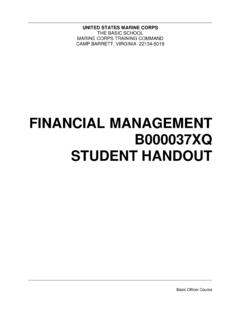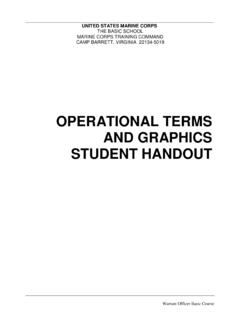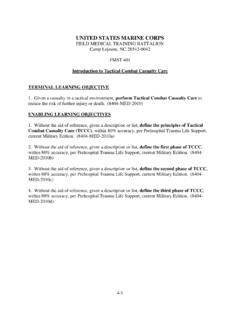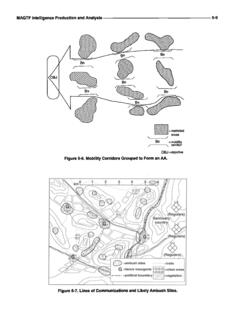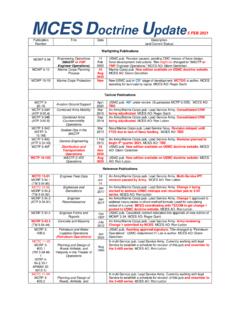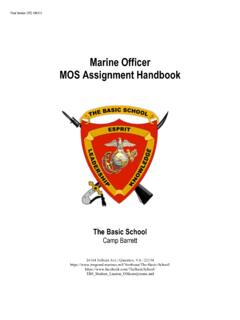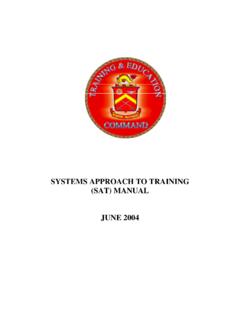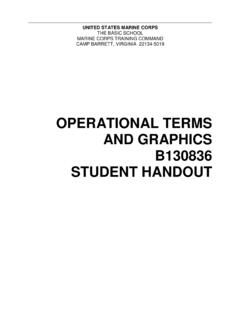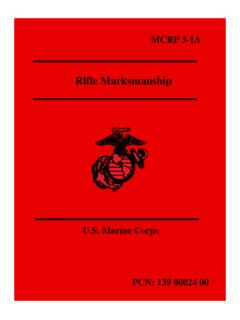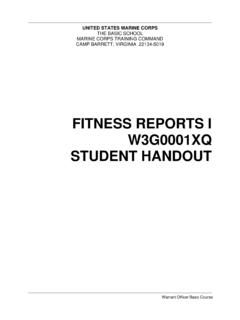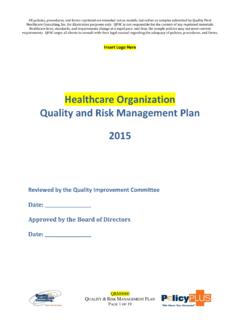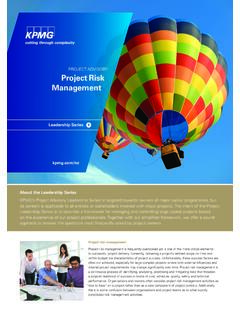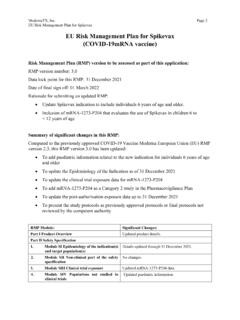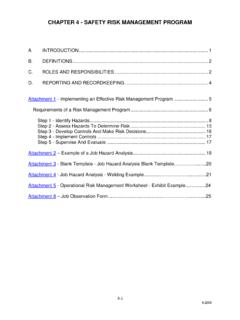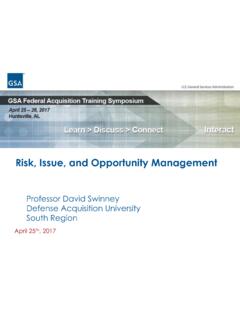Transcription of OPERATIONAL RISK MANAGEMENT B130786 STUDENT …
1 UNITED STATES MARINE CORPS THE BASIC SCHOOL MARINE CORPS TRAINING COMMAND CAMP BARRETT, VIRGINIA 22134-5019 OPERATIONAL RISK MANAGEMENT B130786 STUDENT HANDOUT Basic Off icer Course B130786 OPERATIONAL Risk MANAGEMENT 2 Basic Officer Course OPERATIONAL Risk MANAGEMENT (ORM) Introduction This purpose of this class is to provide basic instruction on the fundamentals of OPERATIONAL Risk MANAGEMENT (ORM) and to highlight the procedures and responsibilities that all Marines must take in both an OPERATIONAL and non- OPERATIONAL environment in order to identify hazards and eliminate or reduce the risks associated with them.
2 Importance OPERATIONAL Risk MANAGEMENT is eve ry Marine s duty and responsibility, regardless of rank. By properly applying the fundamentals of ORM, Marines have the ability to correct ly identify hazards and eliminate unnece ssary risk or reduce necessary risk to an acceptable leve l. In This Lesson This lesson co vers the following topics: Topic Page Risk MANAGEMENT Fundamentals 4 OPERATIONAL Risk MANAGEMENT (ORM) Principles 5 ORM 5 Step Process/ BAMCIS/METT-T 6 ORM Levels 13 Summary/CMC Guidance 13 References 14 Glossary of Terms and Acronyms 14 Notes 15 B130786 OPERATIONAL Risk MANAGEMENT 3 Basic Officer Course OPERATIONAL Risk MANAGEMENT (ORM) (Continued) Learning Objectives Terminal Learning Objectives TBS-TRNG-2008 Given an OPERATIONAL Risk Assessment Worksheet (ORAW)
3 , training materials, training plan , and with the aid of references, conduct OPERATIONAL Risk Assessment to mitigate risks associated with each training event by identifying and incorporating control measures through the OPERATIONAL Risk Assessment Worksheet (ORAW) in accordance with the references. Enabling Learning Objectives TBS-TRNG-2008a Given an OPERATIONAL Risk Assessment Worksheet (ORAW), training materials, training plan , and with the aid of references, identify hazards to mitigate risks associated with each training event by identifying and incorporating control measures through the OPERATIONAL Risk Assessment Worksheet (ORAW).
4 TBS-TRNG-2008b Given an OPERATIONAL Risk Assessment Worksheet (ORAW), training materials, training plan , and with the aid of references, assess hazards to mitigate risks associated with each training event by identifying and incorporating control measures through the OPERATIONAL Risk Assessment Worksheet (ORAW). TBS-TRNG-2008c Given an OPERATIONAL Risk Assessment Worksheet (ORAW), training materials, training plan , and with the aid of references, make risk decisions to mitigate risks associated with each training event by identifying and incorporating control measures through the OPERATIONAL Risk Assessment Worksheet (ORAW).
5 TBS-TRNG-2008d Given an OPERATIONAL Risk Assessment Worksheet (ORAW), training materials, training plan , and with event by identifying and incorporating control measures through the OPERATIONAL Risk Assessment Worksheet (ORAW). TBS-TRNG-2008f Given an OPERATIONAL Risk Assessment Worksheet (ORAW), training materials, training plan , and with the aid of references, describe how to assess effectiveness of control measures to ensure continued safety throughout each training event. TBS-TRNG-2008g Without the aid of reference, describe the purpose of OPERATIONAL risk assessment, without error.
6 TBS-TRNG-2008h Given an evaluation, describe safety as part of professionalism without error. B130786 OPERATIONAL Risk MANAGEMENT 4 Basic Officer Course Risk MANAGEMENT Fundamentals Risk MANAGEMENT is the proce ss of identifying, assess ing, and controlling risks arising from OPERATIONAL factors and maki ng deci sions that balance risk co sts with mission benefits. Leaders and Marines at all levels use risk MANAGEMENT . It applies to all missions and environments across the wide range of Marine Corps operations.
7 Risk MANAGEMENT is fundamental in developing confident and co mpetent leaders and units. Proficiency in applying risk MANAGEMENT is critica l to conserving co mbat power and reso urce s. Commanders must firmly ground cu rrent and future leaders in the cr itica l sk ills of the five -step risk MANAGEMENT process. What is risk? Risk is characterized by both the probability and se ve rity of a potential loss that may resu lt from hazards due to the presence of an enemy, adversary, or so me other hazardous condition.
8 Perception of risk varies from person to person. What is risky or dangerous to one person may not be to another. Perception influences leaders decisions. A publicize d event su ch as a training accident or a relative ly minor incident may increase the public s perception of risk for that particu lar event and time so metimes to the point of making su ch risk s unacceptable. Failure to effective ly manage the risk may make an operation too costly politica lly, eco nomica lly, and in terms of co mbat power (Marines live s and equipment).
9 O The two types of risk that exist across the wide range of Marine Corps operations are tactica l risks and accident risks . Tactica l risk is risk conce rned with hazards that exist because of the presence of either the enemy or an adversary. It applies to all leve ls of war and across the spectrum of operations. Accident risk incl udes all OPERATIONAL risk considerations other than tactical risk. It includes risks to the friendly force . It also includes risks posed to civilians by an operation, as well as an operation s impact on the environment.
10 It ca n include act ivities ass ociated with hazards concerning friendly personnel, civilians, equipment readiness, and environmental co nditions. Risk MANAGEMENT applies to all situations and environments across the wide range of Marine Corps operations, activities, and process es. Risk MANAGEMENT is use ful in developing, fielding, and employing the total Marine Corps force . Risk MANAGEMENT assists the commander or leader in: Conserving live s and resources and avo iding unnecessary risk.
